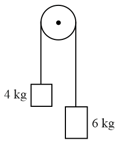HARD
Earn 100
STATEMENT-1: Gas ejected from the rocket will never exert thrust on the rocket if the ejected gas and the rocket move in the same direction.
STATEMENT-2: If the thrust force is to be exerted on the rocket in its direction of motion, the ejected gas (w.r.t. rocket) must move opposite to the velocity of rocket (w.r.t. ground).
(a)Statement-1 is True, Statement-2 is True; Statement-2 is a correct explanation for Statement-1.
(b)Statement-1 is True, Statement-2 is True; Statement-2 is NOT a correct explanation for Statement-1
(c)Statement-1 is True, Statement-2 is False
(d)Statement-1 is False, Statement-2 is True
50% studentsanswered this correctly
Important Questions on Laws of Motion
MEDIUM
Calculate the acceleration of the block and trolly system shown in the figure. The coefficient of kinetic friction between the trolly and the surface is ( mass of the string is negligible and no other friction exists).

EASY
EASY

MEDIUM
EASY
HARD
MEDIUM
EASY
EASY
MEDIUM
MEDIUM
EASY
EASY
MEDIUM
MEDIUM
EASY
MEDIUM
HARD
MEDIUM
EASY

